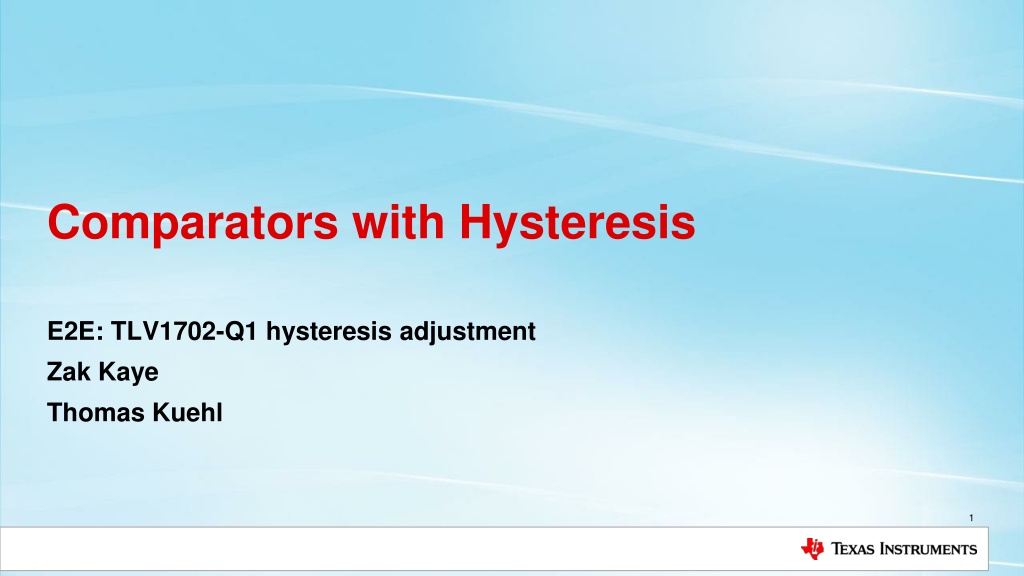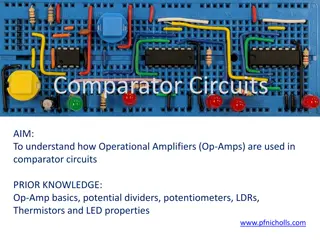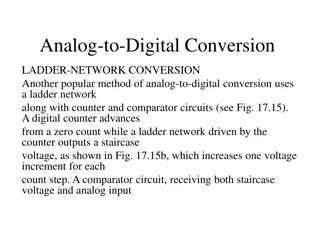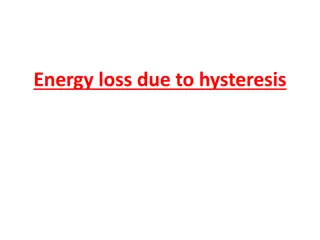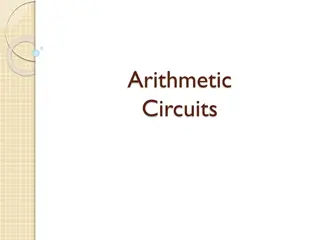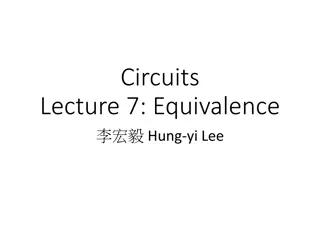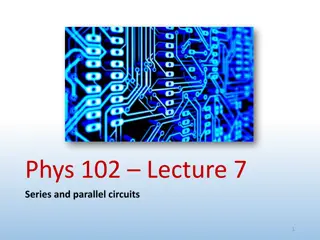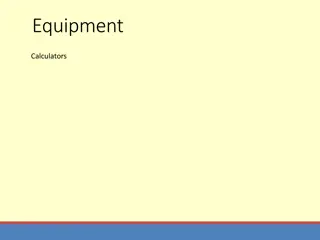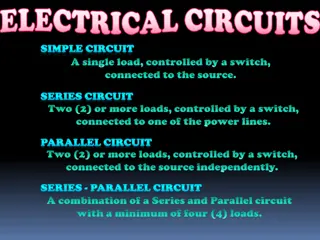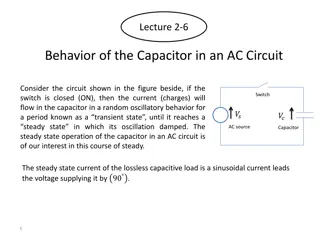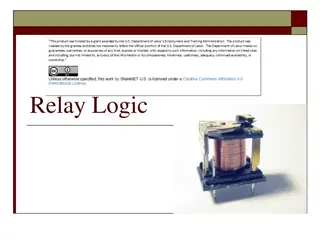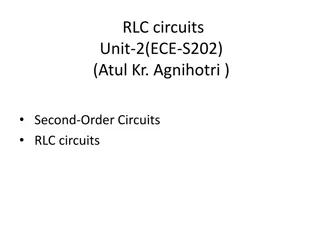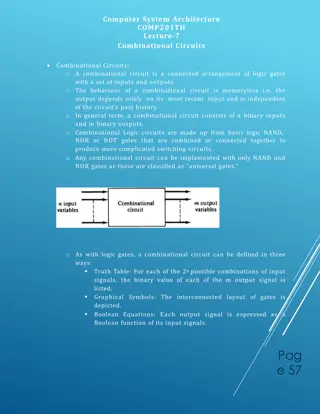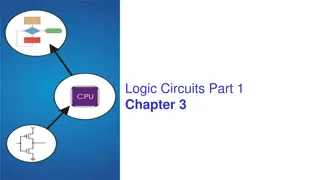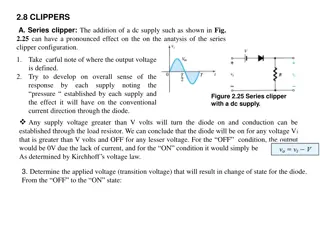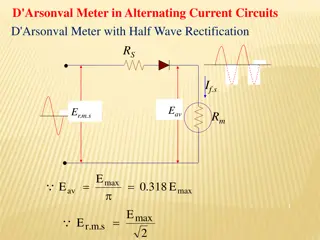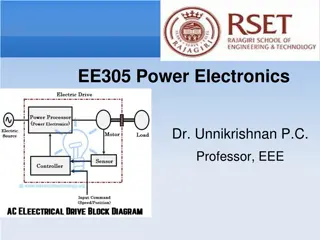Understanding and Implementing Hysteresis in Comparator Circuits
Comparator circuits with hysteresis play a crucial role in signal processing applications. This article explores the theory behind comparator functions, hysteresis adjustment, and practical implementation using the TLV1701-Q1 series. Learn how to set up non-inverting and inverting comparators with hysteresis, optimize resistor values, and enhance accuracy through simulation. Find guidelines for applying hysteresis effectively in push-pull comparator circuits.
Download Presentation

Please find below an Image/Link to download the presentation.
The content on the website is provided AS IS for your information and personal use only. It may not be sold, licensed, or shared on other websites without obtaining consent from the author. Download presentation by click this link. If you encounter any issues during the download, it is possible that the publisher has removed the file from their server.
E N D
Presentation Transcript
Comparators with Hysteresis E2E: TLV1702-Q1 hysteresis adjustment Zak Kaye Thomas Kuehl 1
The Comparator function + + 5 V Rp 10 k V1 and V2 are two input voltages applied to +IN and -IN inputs Either one may be a dc level, or a changing ac signal Vout can be one of two levels; VH high (1), or VL low (0) VH V+ and VL 0 V, or GND Non-inverting condition If V1 > V2, Vout will be high If V1 < V2, Vout will be low Inverting condition If V2 > V1, Vout will be low If V2 < V1, Vout will be high V+ Vout -IN Vout Vin 2.5 V V2 +IN 100 uA + + 0.1 V V1 2
Setting up a comparator circuit to use hysteresis Non-inverting comparator, open-collector Goals VHYST 100 mV, Vref 2.5 V Let Vcc = 5 V, VO(max) = 5 V, VO(min) = 50 mV R1 = 100 K, Rpull-up = 10 k Then R2 = 104 5.0 2.5 1 R1 = = 100 k Vcc Vref 1 105 105 105+105 = 50 k R1 R2 R1+R2 = R3 = ??(???) ??(???) VHYST 5.0 0.05 0.10 1 = 5 104 R4 = R3 1 Equations simplified by setting Rpull-up < 0.1*R4 Threshold voltage errors are in low percent range R4 = 2.43 MEG 3
Setting up a comparator circuit to use hysteresis TLV1701 Non-inverting comparator, open-collector, 100 mV HHYST VH = 2.55 V VL = 2.45 V VHYST = 100 mV TINA-TI simulation and verification Hysteresis accuracy improves with Rpull-up < 0.1 R4 Equations can be used for push-pull output too! 4
Setting up a comparator circuit to use hysteresis TLV1701 Inverting comparator, open-collector Let Goals Vcc = 5 V, VO(max) = 5.0 V, VO(min) = 0.05 V VHYST = 50 mV, Vref = 2.5 V R1 = 10 k, Rpull-up = 10 k Then R2 = 104 5.0 2.5 1 ?1 = = 10 k ??? ???? 1 ??(???) ??(???) VHYST ?1 ?2 ?1+?2 R3 = 1 104 104 104+104 5.0 0.05 0.05 R3 = 1 = 490 k 5
Setting up a comparator circuit to use hysteresis Inverting comparator, open-collector, 50 mV VHYST VH = 2.52 V VL = 2.47 V VHYST = 49.5 mV TINA-TI simulation and verification Hysteresis accuracy improves with Rpull-up < 0.1 R3 Equations can be used for push-pull output too! 6
Setting up a comparator circuit to use hysteresis Some guidelines when applying hysteresis Push-pull comparators with hysteresis applied The resistor values directly affect the reference voltage and the VH and VL levels. Their tolerances are an important factor in hysteresis accuracy Keeping Rpull-up 10 % of the feedback resistor value for open-drain/ collector outputs assures more accurate VHand VL voltage levels The inverting and non-inverting equations can be used for push-pull output comparators Use the datasheet Output Voltage vs Output Current curves to establish VO(max)and VO(min)from the VOH and VOL levels 7
